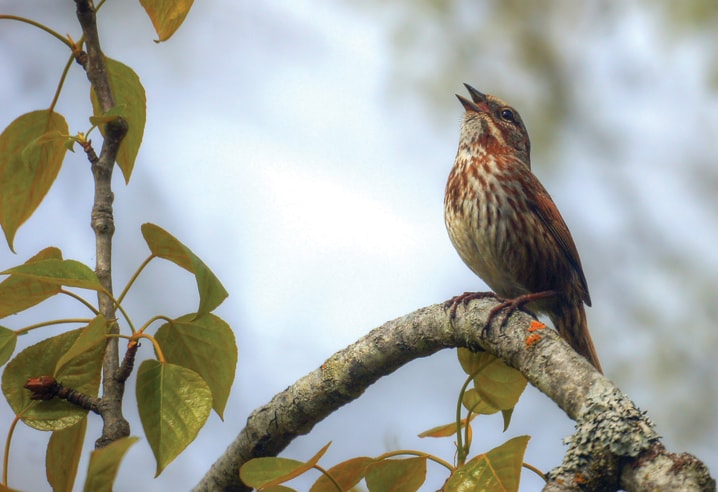Why wasn’t this intruder getting the message?
The lord of the manor had warned him repeatedly to back off, with threatening gestures and loud admonitions. But the trespasser just sat there — singing.
The time for detente was past. In a flurry of feathers, the resident sparrow dived for his challenger’s head.
“They have personalities,” said Michael Beecher, watching from a few feet away as the furious bird pecked and clawed at the rival male. “Some are more laid back, but this is an attacking bird.”
The University of Washington biologist stepped in to terminate the brawl, retrieving the stuffed sparrow and mini-speaker that tricked the real bird into believing his territory had been overrun.
Foe vanquished, the sparrow fluffed himself up, perched high in a tree and let loose a cascade of trills and whistles.
“That’s the king-of-the-mountain song,” Beecher said.
Beecher understands better than most the messages that pass between song sparrows. He and his students have been studying the birds’ communication patterns in Seattle’s Discovery Park for more than 25 years.
The duel he orchestrated on a recent morning provided an opportunity to record the sotto voce song that males use only when confronting interlopers.
Celebrated by poets and welcomed as a harbinger of spring, the seasonal outpouring of bird song also is a focus of research for scientists interested in animal behavior, like Beecher, and those who want to understand human thought and learning.
Nineteenth-century poet Percy Bysshe Shelley couldn’t have guessed he was foretelling a branch of neuroscience when he hailed the skylark: “Teach me half the gladness that thy brain must know.”
The way birds learn their songs is similar to the way babies learn to talk and adults master a golf swing, brain researchers say. And studies of the seasonal changes in birdbrains are revealing neurological twists that might be harnessed to heal human brains damaged by stroke, Alzheimer’s disease and other disorders.
“The strength of the songbird system is that you can go down to the very detailed, micro-level ... then explain how that leads to changes in behavior,” University of Washington neurobiologist David Perkel said. “That’s something not a lot of neuroscience can do.”
It was research on songbirds that upset the long-held notion that most animals and most humans were born with all the gray matter they would ever have.
Working with canaries and chickadees in the 1980s, Fernando Nottebohm at The Rockefeller University in New York City found brain regions associated with song and the ability to locate hidden caches of food were constantly birthing new cells.
Scientists soon discovered neurons sprouting in other brain areas and in the brains of other animals, including Homo sapiens.
But nothing in the human brain comes close to the transformation male birds undergo as they ride a roller coaster of hormones that peaks this time of year, said Eliot Brenowitz, professor of biology and psychology at the University of Washington.
Brenowitz is working to understand how a spring spike in testosterone causes the parts of the brain that control song to double or triple in size.
“It’s the brain’s version of an athlete bulking up on steroids,” he said.
In the white-crowned sparrows Brenowitz studies, the birds’ vocal skills improve in concert with the changes inside their heads. In winter, their songs are scratchy and jumbled. By early March, everyone is following the appropriate score and performing like Pavarotti.
“If you go out now,” Brenowitz said, “the songs are clean, they’re crisp and they’re beautiful to listen to.”
The birds produce new neurons year-round, but the testosterone surge enables more of those cells to survive and grow at a time when males need maximum brainpower to attract a mate, fight off rivals and defend territory.
After the chicks fledge in late summer and the father birds relax, their testosterone levels drop and song neurons die off like falling leaves.
That’s when things get really interesting to Brenowitz. The death of brain cells seems to accelerate production of replacements. Few of the new cells survive in the fall and winter, when testosterone levels are low.
But the phenomenon tracks what happens in people who have lost brain cells to a stroke. Other parts of their brains begin producing new neurons. The effect isn’t robust enough to heal the damage, but bird studies may reveal ways to give it a boost, Brenowitz said.
“There’s a lot of hope that this will lead to a way to try to repair damaged brains,” he said.
